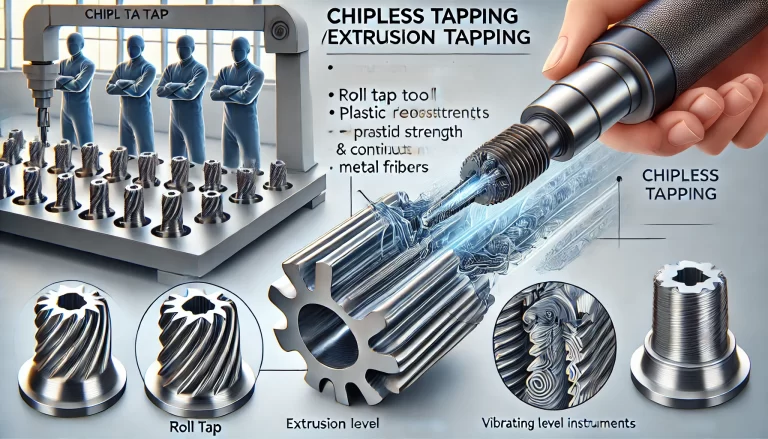Abstract
Chipless tapping, also known as extrusion tapping or roll tapping, is an internal threading process based on the principle of metal plastic deformation. This article provides a detailed explanation of the definition, advantages, and application scenarios of chipless tapping, particularly in vibrating level instruments.
1. Definition of Chipless Tapping
Chipless tapping, also referred to as roll tapping or extrusion tapping, is a unique threading process that forms internal threads by plastically deforming the workpiece material rather than cutting it away. During the process, the threading tool, known as a roll tap, displaces and compresses the metal within the pre-drilled hole, causing the material to flow and fill the tap’s thread profile. Once the tap is removed, a precisely formed internal thread is left behind.
Unlike conventional cutting taps, chipless tapping does not generate any waste material or chips, as it relies solely on deformation rather than material removal. This makes the process particularly suitable for applications requiring clean and precise threads without the risk of contamination from metal debris.

2. Characteristics of Chipless Tapping
2.1 Metal Flow and Plastic Deformation
Chipless tapping takes advantage of the plastic deformation properties of metals. As the roll tap engages the workpiece, the material flows under pressure and is reshaped into a fully formed thread with enhanced structural integrity.
2.2 Thread Profile
Extrusion Profile: The thread produced by chipless tapping has a distinct profile, often with a rounded crest that resembles a U-shape due to the material displacement process.
Continuous Metal Fibers: Unlike cutting taps that sever the metal fibers, chipless tapping preserves the continuity of the material’s structure, leading to improved mechanical properties.
No Chip Formation: Since no material is removed, there is no need for chip management, making this process ideal for applications such as blind holes where chip evacuation is challenging.

3. Advantages of Chipless Tapping
3.1 Increased Thread Strength and Wear Resistance
Higher Strength: Due to the continuous fiber structure and work hardening effects from plastic deformation, chipless-tapped threads exhibit greater tensile and shear strength compared to cut threads.
Enhanced Wear Resistance: The cold-working effect results in a hardened surface layer that provides superior resistance to wear and fatigue.
3.2 High Precision and Consistency
Dimensional Accuracy: The absence of chip formation eliminates the possibility of debris interfering with the thread geometry, ensuring high precision.
Uniformity: The repeatable nature of chipless tapping ensures consistency across multiple parts, making it suitable for mass production.
3.3 Improved Efficiency and Automation Compatibility
Higher Productivity: Chipless tapping typically operates at higher speeds than conventional cutting taps, significantly improving production efficiency, especially in soft materials like aluminum and copper alloys.
Automation Friendly: The predictable and stable process makes it easier to integrate into automated manufacturing systems.
3.4 Cost Savings
Reduced Tool Wear: Roll taps experience less wear and have a longer service life compared to cutting taps.
Lower Processing Costs: The elimination of chip disposal and reduced machine downtime contribute to overall cost efficiency.
3.5 Environmental and Energy Benefits
Waste-Free Processing: Since no chips are generated, there is no need for disposal, reducing environmental impact.
Energy Savings: The efficiency of the process results in lower energy consumption compared to traditional machining.

4. Application of Chipless Tapping in Vibrating Level Instruments
Chipless tapping has found significant applications in vibrating level instruments, such as tuning fork and vibration rod level switches. The advantages of this process provide critical benefits in these applications:
4.1 Enhancing Operational Reliability
In vibrating level switches, such as tuning fork liquid level sensors, piezoelectric ceramic components must be securely fixed to ensure accurate operation. Conventional cutting taps produce chips that can lodge in critical areas, potentially affecting sensor accuracy and performance. Chipless tapping eliminates this risk by providing a clean and precise thread without debris.
4.2 Improving Equipment Stability
Threads formed through chipless tapping are smoother, stronger, and exhibit higher resistance to loosening under dynamic loads. This ensures that vibrating level sensors maintain their calibration and stability over prolonged operation.
4.3 Case Study: Tube-11 Vibrating Rod Level Switch
In instruments such as the Tube-11 vibrating rod level switch by Jiwei Automation, chipless tapping is used in the assembly of vibrating probe components. The absence of chips prevents contamination of sensitive parts, contributing to the longevity and reliability of the device.

5. Future Prospects of Chipless Tapping
With the growing demand for precision engineering in various industries, chipless tapping is expected to see further adoption in sectors such as automotive, aerospace, and medical devices. Advances in tool materials and coatings will likely expand its applicability to harder materials and more complex geometries.
Conclusion
Chipless tapping is a highly advantageous method for forming internal threads, offering superior strength, precision, efficiency, and environmental benefits. Its application in vibrating level instruments showcases its potential in enhancing product reliability and operational efficiency. As technology continues to evolve, chipless tapping is set to become an even more integral part of modern manufacturing.
